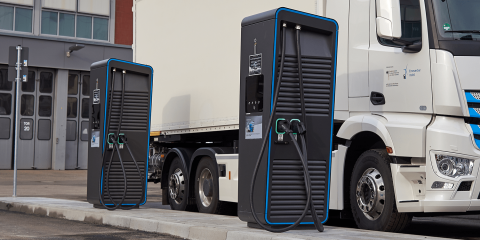Existing grid infrastructure can handle influx of e-trucks without major upgrades: NREL
A new study conducted by a team of researchers at the National Renewable Energy Laboratory (NREL) has suggested that existing power grid infrastructure seems to be ready to handle an influx of commercial electric trucks.
The researchers looked at increased demand for electricity from commercial EVs operating relatively short distances by modeling the potential demand on power substations using data from real-world diesel-guzzling delivery fleets. Of the power substations studied, nearly 80 per cent were found to be capable of supporting commercial fleets of up to 100 trucks without any need for major upgrades.
It is worth-mentioning here that the researchers assumed that fleets would use the highest-available charging speeds. In case the fleets chose lower speeds, the need for upgrading power grid infrastructure would be even lower. Getting commercial vehicles back in operation quickly will likely require megawatt-scale charging, which would require much greater power demand than existing DC fast-charging sites for passenger four-wheelers.
Brennan Bourlag, the lead author of the study, added that the next step was electrifying long-haul semis. For longer-distance delivery commercial vehicles and long-haul e-trucks, some entities have already started modeling what the e-truck stop of the future should look like. Thus, the findings of the study could be of great help to such entities.
Earlier this year, Portland General Electric (GE) in partnership with the North American division of Daimler Trucks opened the first public U.S. charging station for heavy-duty commercial EVs, called Electric Island. Separately, a group of West Coast utilities are busy in collaborating with one another to transform I-5 into an electric highway for commercial heavy-duty vehicles.
However, it remains unclear when electric heavy-duty commercial vehicles will start operating in large numbers. A previous study, published in 2019, found that the higher initial cost of long-haul electric semi trucks did not yet work out for fleets.
In the month of June last year, California announced a new EV policy, mandating manufacturers to start selling e-trucks in 2024, and sell only e-trucks in the Golden State by 2045. A month later, in July 2020, fifteen states signed an agreement to make new medium-duty and heavy-duty e-trucks in their jurisdictions fully-electric by the end of 2050. By that time, prices of commercial EVs would likely come significantly down through new technologies and economies of scale.
The encouraging findings of the study appeared in the most recent edition of the Nature Energy, a monthly peer-reviewed scientific journal published by the Nature Publishing Group.
